Mastering English: A Comprehensive Guide to Verb Forms
Welcome to “Mastering English: A Comprehensive Guide to Verb Forms,” your definitive resource for verb usage in the English language. As you delve into the following pages, you will embark on a linguistic journey. This guide, filled with a broad spectrum of 1,000 verb forms, aims to provide you with the tools essential for constructing grammatically accurate sentences. Whether you’re a novice English learner or an experienced speaker hoping to refine your skills, this guide is designed to help you navigate the intricacies of English verb usage with ease and confidence. Let’s begin this fascinating exploration into the dynamic world of English verbs.
May Can Help You :
The Most Commonly Used Verbs in the English Language
English Collocations For Phrasal Verbs
English course : Conjugation of DO verb
Definition and Importance of Verbs
Verbs are the action words in a sentence that describe what the subject is doing. Along with nouns, verbs are the main part of a sentence or phrase, telling a story about what is taking place. In fact, without a verb, full thoughts can’t be properly conveyed, and even the simplest sentences, such as Maria sings, have one. Essentially, a verb is the main component of a predicate in a sentence.
Different Types of Verbs
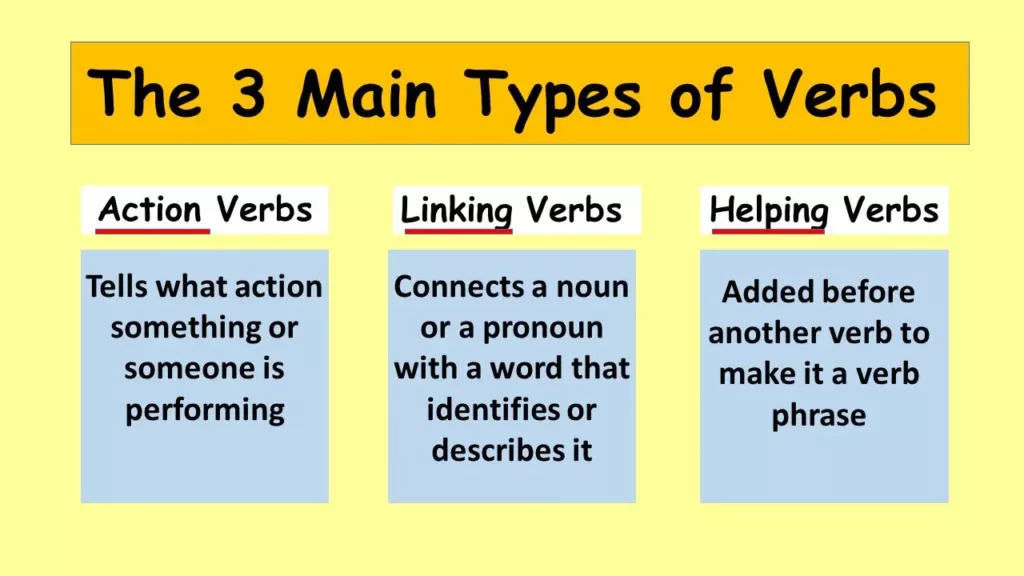
There are several types of verbs that perform different functions in sentences. These include:
- Action Verbs: These are verbs that express physical or mental action. For example, run, swim, think, or study.
- Linking Verbs: These verbs do not express action; instead, they connect the subject of the verb to additional information about the subject. Examples include, is, am, are, was, were.
- Helping Verbs (Auxiliary Verbs): These verbs extend the meaning of the base verb, and are necessary for grammatical structure of a sentence. They include verbs like, have, has, do, does, can, could.
- Modal Verbs: These are a type of auxiliary verb that express necessity or possibility. Examples include, must, shall, will, should, would.
- Transitive and Intransitive Verbs: Transitive verbs have a direct object, while intransitive verbs do not. For instance, in the sentence “She reads books,” “reads” is a transitive verb and “books” is its object. However, in the sentence “She reads,” “reads” is an intransitive verb as it has no direct object.
Understanding the different types of verbs and their uses helps to craft more effective and meaningful sentences.
Regular Verb Conjugation Rules and Examples
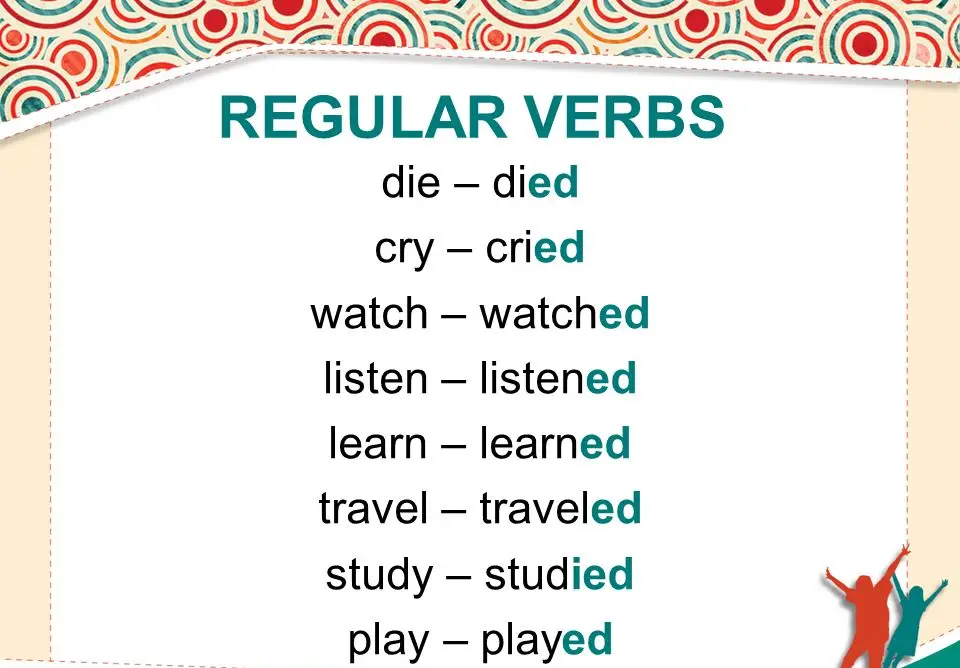
Regular verbs in English follow a predictable pattern in their conjugation. Here are the general rules:
- Present Tense: The base form of the verb is used. For example, play, work, live.
- Past Tense: The verb ends with ‘-ed’. For example, played, worked, lived.
- Future Tense: The verb is preceded by ‘will’. For example, will play, will work, will live.
- Past Participle: The verb ends with ‘-ed’. It is used with has, have, or had. For example, has played, have worked, had lived.
- Present Participle: The verb ends with ‘-ing’. It is used with is, am, are, was, or were. For example, is playing, am working, are living.
Remember, these rules apply to regular verbs in English. Irregular verbs, on the other hand, do not follow these rules and must be learned individually.
Irregular Verbs
- Irregular verbs, unlike regular ones, do not follow a set pattern in their conjugation. This can make them a bit challenging to master. For instance:
- Present Tense: go, have, do
- Past Tense: went, had, did
- Future Tense: will go, will have, will do
- Past Participle: gone, had, done
- Present Participle: going, having, doing
Each irregular verb has its own unique pattern, and the best way to learn these is through practice and regular use. Despite their complexity, irregular verbs are crucial for fluent and natural English communication.
English Verb Conjugation Rules
- The conjugation of English verbs is essential to understanding and correctly using different tenses. Conjugation involves changing a verb form to provide information about the action it’s describing. Here are some general rules to remember when conjugating English verbs:
- Subject-Verb Agreement: A verb must agree in number with its subject. Singular subjects take singular verbs, and plural subjects take plural verbs. For example, She runs (singular), They run (plural).
- Tense Agreement: The tense of a verb indicates the time at which an action takes place. English verbs have six tenses: three simple (present, past, future) and three perfect (present perfect, past perfect, future perfect). The tense of the verb in a sentence reflects the time at which the action is expected to occur.
- Mood and Voice: These are two aspects of verbs that are often overlooked. Mood refers to the attitude of the speaker toward the action/state of the verb and includes the indicative, imperative, and subjunctive moods. The voice of a verb (active or passive) indicates whether the subject of the sentence is performing or receiving the action.
Understanding the rules of conjugation will enable you to use verbs correctly in English, improving your written and spoken communication.
Transitive and Intransitive Verbs
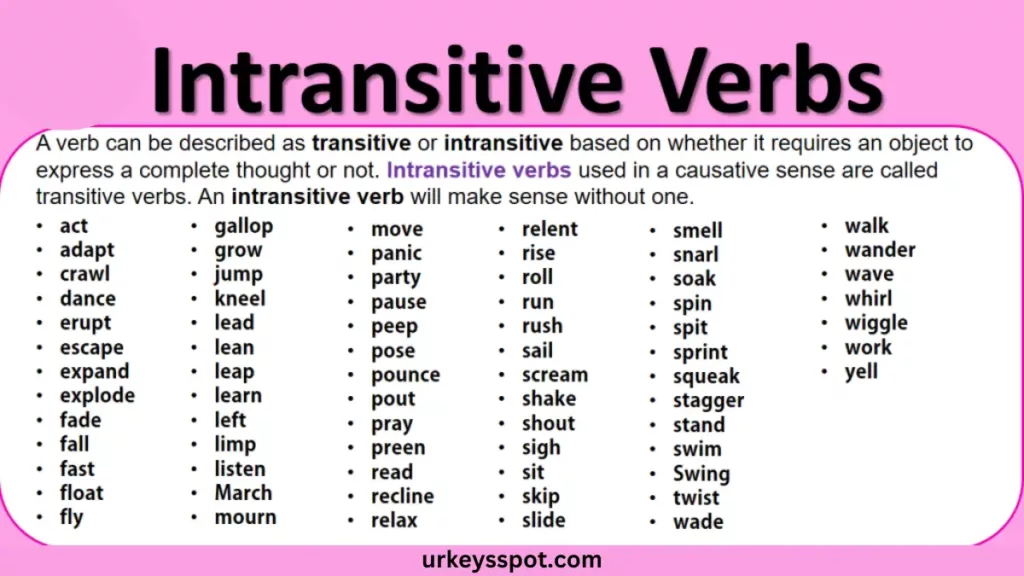
- Transitive and intransitive verbs serve different roles in English syntax and are distinguished by their function in a sentence.
- Transitive Verbs: As mentioned earlier, these verbs take a direct object, that is, they transfer their action to something or someone—an object. The sentence “She bakes cookies” is an example. Here, “bakes” is a transitive verb that is transferring action to the object, “cookies.”
- Intransitive Verbs: On the other hand, these verbs don’t take a direct object. Their action doesn’t transfer to anything or anyone. For instance, in the sentence “She runs”, “runs” is an intransitive verb. Here, no action is being transferred.
Remember, some verbs can function both as transitive and intransitive depending on the context. For example, in the sentence “He reads” (He reads what?), “reads” is transitive. But in “He reads well”, “reads” is an intransitive verb. Understanding the difference between these two types of verbs will aid in constructing grammatically accurate and meaningful sentences.
- Here are some examples of how verbs are used in sentences:
Action Verbs:
- He runs five miles every day.
- She studies for four hours each night.
Linking Verbs:
- Our teacher is very understanding.
- The flowers smell lovely.
Helping Verbs (Auxiliary Verbs):
- I have completed my assignment.
- She does not like spinach.
Modal Verbs:
- He must complete his project by tomorrow.
- You should take an umbrella, as it might rain later.
Transitive Verbs:
- She reads the newspaper every morning.
- I love chocolate cake.
Intransitive Verbs:
- The baby cries a lot.
- He sits in the same spot every day.
Understanding these examples will help you see how to properly use these different types of verbs within your own sentences.
Auxiliary Verbs
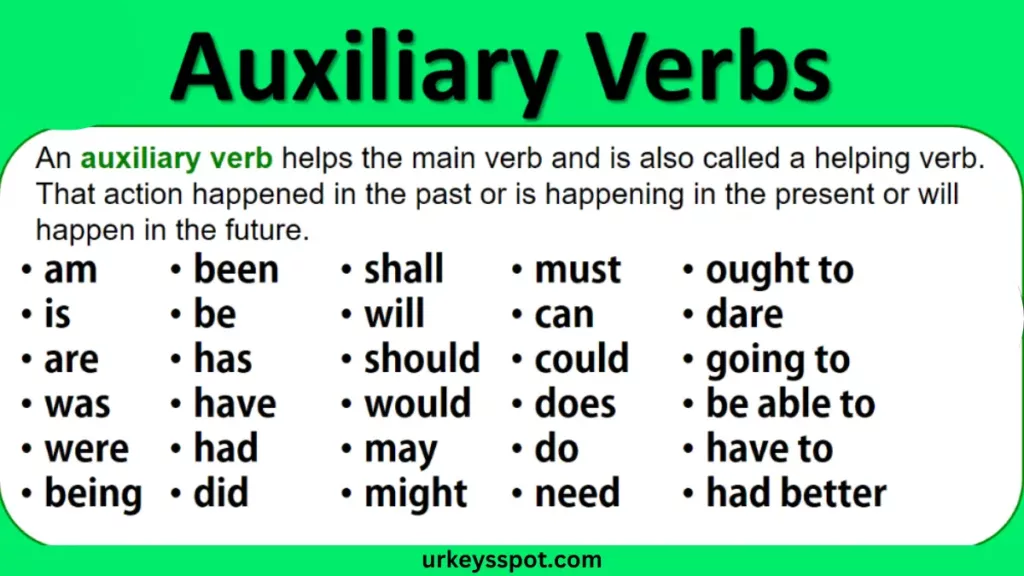
- Auxiliary verbs or helping verbs, as the name suggests, are used in conjunction with main verbs to express the mood, tense, voice, and aspect of the action or state indicated by the main verb. They “help” to enhance the meaning of the main verb, providing additional information and context about the action. Examples of auxiliary verbs include “be”, “have”, and “do”, as well as the modal verbs “can”, “may”, “should”, etc. For instance, in the sentence “She is singing a song”, ‘is’ is an auxiliary verb that helps to indicate the present continuous tense of the action. Similarly, in the sentence “He has written a book”, ‘has’ is an auxiliary verb that denotes the perfect aspect of the action. Understanding and correctly using auxiliary verbs is key to mastering English verb usage and enhancing your language fluacny.
- Here are some examples illustrating the use of auxiliary verbs in sentences:
Be
- She is playing piano.
- We were watching a movie.
Have
- I have read that book.
- They have visited the Eiffel Tower.
Do
- Does he do his homework regularly?
- Did you do the laundry?
Modal Verbs
- You should finish your meal.
- He will attend the meeting.
- Can she dance?
Learning through practical examples aids in the understanding of auxiliary verbs and their application in daily English communication. Remember, practice is essential in mastering the use of these verbs.
Modal Verbs
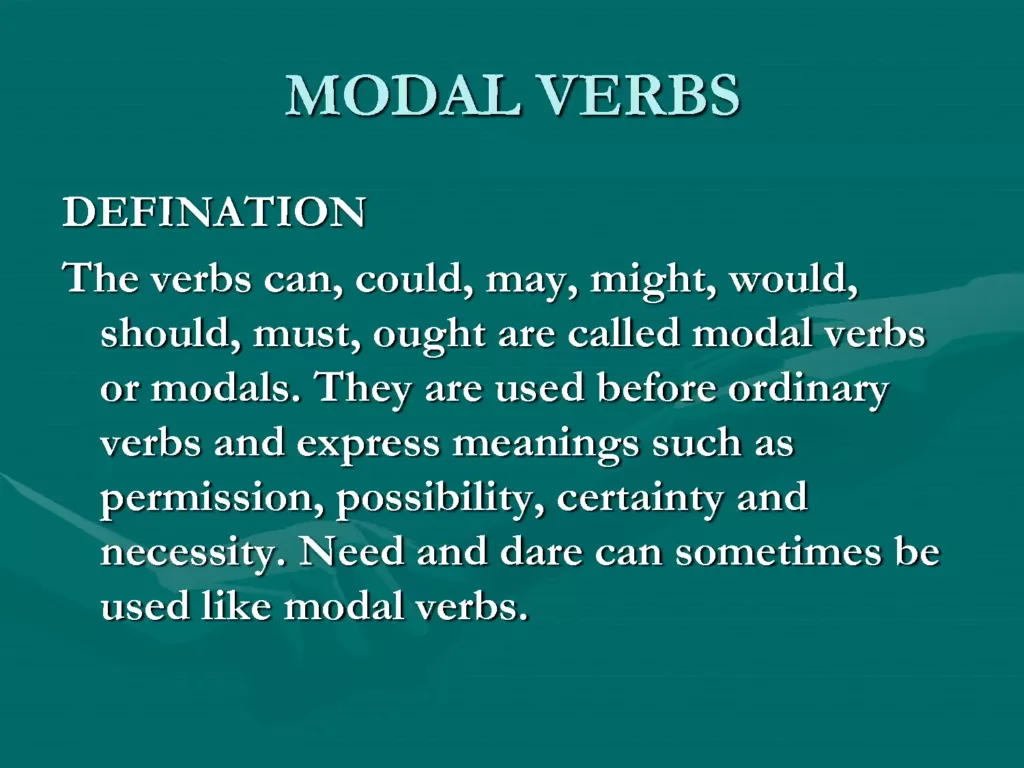
- Modal verbs are special types of auxiliary verbs that convey a certain mood or necessity of the action or condition expressed by the main verb. These verbs are used to indicate possibility, ability, permission, request, capacity, suggestions, order, and obligation. English modal verbs include “can”, “could”, “may”, “might”, “shall”, “should”, “will”, “would”, “must”, and “ought to”. Unlike other verbs, modal verbs do not change their form (they have no -s, -ing, -ed forms) and they are followed by a base form of a verb. For instance, in the sentence “You must study for the examination”, ‘must’ is a modal verb that expresses the necessity or obligation of the action ‘study’. Understanding and applying modal verbs correctly is crucial to expressing different shades of meaning in English communication.
- Usage Examples
Phrasal Verbs
- Phrasal verbs are a unique type of verb found in the English language that are made up of two or three words – a main verb combined with an adverb or a preposition. The combination of these words creates a new meaning, which often bears little relation to the meaning of the verb alone. For example, the verb ‘to give’ changes radically when combined with ‘up’ to form the phrasal verb ‘to give up’, which means ‘to quit or to stop doing something’. Phrasal verbs are inherently idiomatic, and their meaning is often difficult to deduce from the constituent words, making them one of the more challenging aspects of English grammar to master. However, they are also crucial to achieving fluency, as they are widely used in various types of informal, casual, and colloquial English communication. Proper understanding and usage of phrasal verbs can significantly enhance one’s ability to communicate effectively and naturally in English.
- Here are some common examples of phrasal verbs in sentences:
Phrasal Verbs
- She turned down the job offer.
- I need to hand in my assignment.
- They came across an old photo while cleaning the attic.
- We have decided to go ahead with the project.
- He put off the meeting until next week.
- She broke up with her boyfriend.
- He ran into an old friend at the supermarket.
- You need to keep up with the latest technology trends.
- They called off the event due to bad weather.
- I look forward to meeting you.
Understanding and practicing these examples can help you get a good grasp of phrasal verbs and their usage in daily English communication.
Verb Tenses
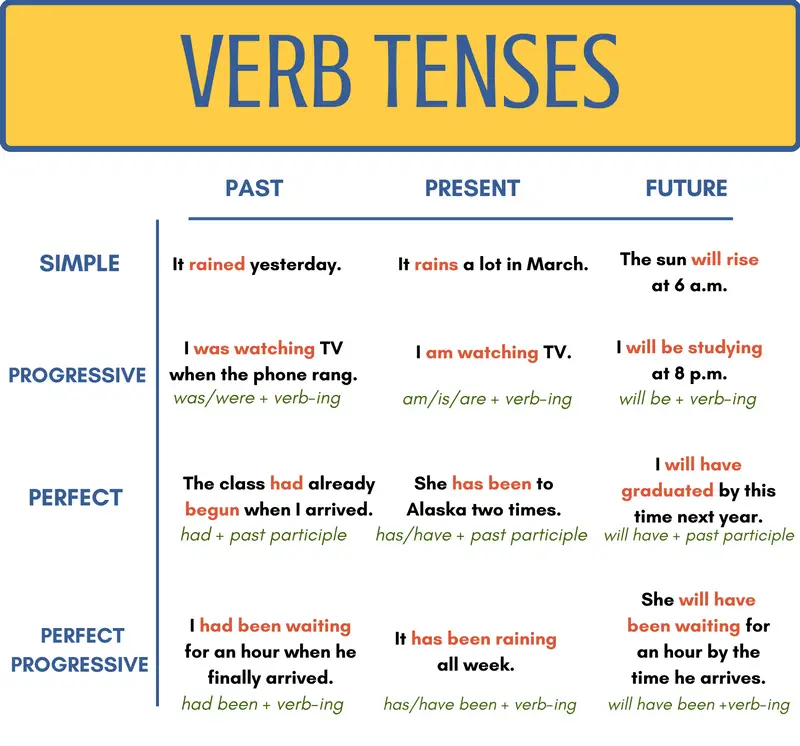
- Verb tenses are essential in English grammar as they allow speakers to express when the event or condition happens – in the past, present, or future. There are three basic tenses in English: past, present, and future. Each of these has four aspects which express the completion or progression of an action at the time. These are: simple, continuous (also known as progressive), perfect, and perfect continuous. Here’s a quick overview:
Simple Tenses
- Past Simple: She walked to the store.
- Present Simple: I go to school.
- Future Simple: They will travel to France next year.
Continuous Tenses
- Past Continuous: I was reading when she arrived.
- Present Continuous: We are studying for the exam right now.
- Future Continuous: He will be working at 5 PM.
Perfect Tenses
- Past Perfect: They had left by the time we arrived.
- Present Perfect: She has eaten lunch already.
- Future Perfect: You will have finished your homework by tomorrow.
Perfect Continuous Tenses
- Past Perfect Continuous: She had been playing piano for an hour when her teacher arrived.
- Present Perfect Continuous: I have been studying English for five years.
- Future Perfect Continuous: We will have been living here for two years next month.
Understanding these tenses and their appropriate usage is key to expressing time accurately in English.
Usage and Examples
Understanding the correct usage of English verbs and their various forms is paramount in mastering the language. Here are some further examples to illuminate the appropriate usage of different types of verbs and their tenses:
Auxiliary Verbs
- Do you understand the concept? (Here, ‘do’ is used as an auxiliary verb to form a question)
Modal Verbs
- She might join us for dinner. (The modal verb ‘might’ expresses possibility)
Phrasal Verbs
- Let’s wrap up the meeting. (‘wrap up’ is a phrasal verb that means to conclude)
Verb Tenses
- Simple Present: They work in the garden every weekend.
- Present Continuous: She is preparing dinner now.
- Present Perfect: I have visited Paris three times.
Remember, the only way to truly master these verbs and their tenses is through consistent practice and application in your everyday English communication.
Verb Conjugation Practice
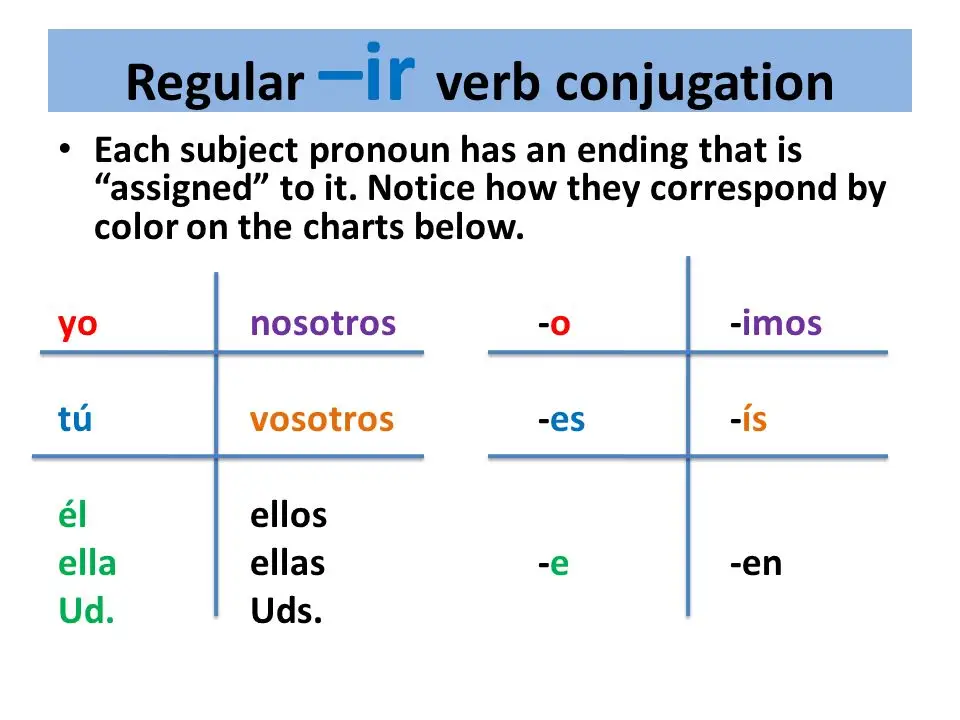
- To enhance your understanding and usage of different types of verbs and their tenses, here are some exercises and examples for you to practice with:
Exercise 1 (Auxiliary Verbs): Fill in the blank with the correct auxiliary verb.
- ___ you ever been to Spain? (Have/Has)
- She ___ not like spicy food. (Do/Does)
- They ___ playing football at the moment. (Is/Are)
Exercise 2 (Modal Verbs): Choose the correct modal verb to complete the sentence.
- You ___ to wear a helmet while riding a bike. (Can/Must)
- ___ I borrow your pen, please? (Can/Should)
- They ___ be at home by now. (Would/Might)
Exercise 3 (Phrasal Verbs): Match the phrasal verbs to their meanings.
- Turn up – a. Cancel
- Call off – b. To proceed with
- Go ahead with – c. Arrive, appear
Exercise 4 (Verb Tenses): Fill in the blank with the correct form of the verb.
- I ___ (go) to the park yesterday.
- She ___ (study) for her test at the moment.
- They ___ (live) in this city for ten years.
Answers:
Exercise 1: 1. Have, 2. Does, 3. Are
Exercise 2: 1. Must, 2. Can, 3. Might
Exercise 3: 1-c, 2-a, 3-b
Exercise 4: 1. Went, 2. Is studying, 3. Have lived
Keep practicing these exercises to improve your verb usage and overall English proficiency.
Our final recommendation is to immerse yourself in the English language as much as possible. Engage in conversations, read books, listen to podcasts, and write essays or stories. Remember, language learning is a continuous process, and every step you take brings you closer to mastery. Do not be disheartened by occasional mistakes. Instead, view them as learning opportunities. With perseverance and dedication, you’ll find your command over English verbs improving over time.

